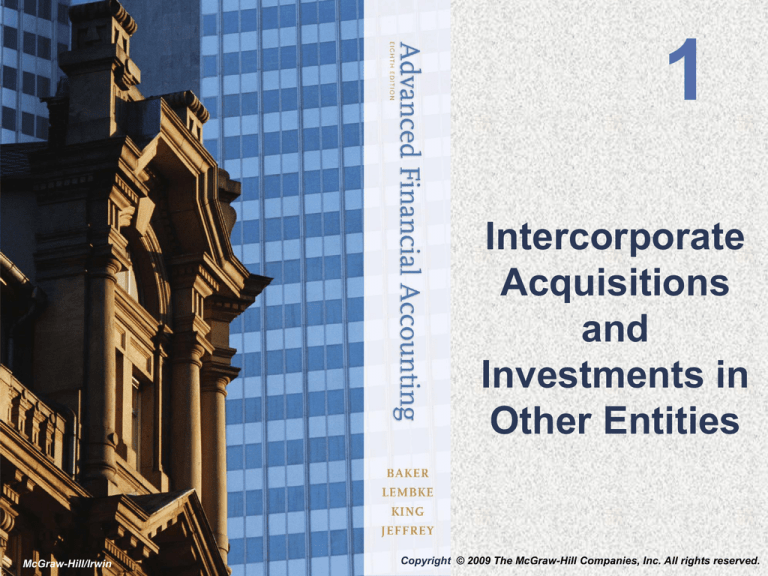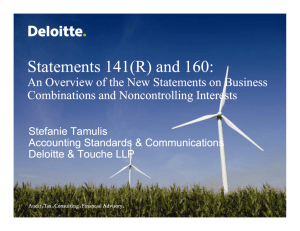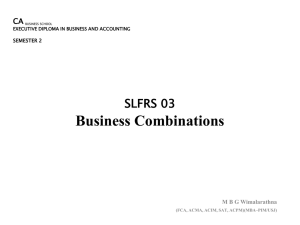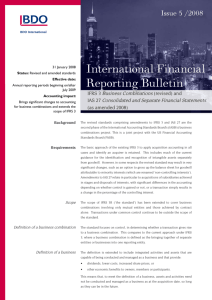
1
Intercorporate
Acquisitions
and
Investments in
Other Entities
McGraw-Hill/Irwin
Copyright © 2009 The McGraw-Hill Companies, Inc. All rights reserved.
The Development of Complex
Business Structures
• Enterprise expansion as a means of
survival and profitability
– Size often allows economies of scale
– New earning potential
– Earnings stability through diversification
– Management rewards for bigger company
size
– Prestige associated with company size
1-2
Organizational Structure and
Business Objectives
• A subsidiary is a corporation that is
controlled by another corporation, referred
to as a parent company, usually through
majority ownership of its common stock
• Because a subsidiary is a separate legal
entity, the parent’s risk associated with the
subsidiary’s activities is limited
1-3
Organizational Structure, Acquisitions,
and Ethical Considerations
• Manipulation of financial reporting
– Usage of subsidiaries or other entities to
borrow money without reporting the debt on
their balance sheets
– Using special entities to manipulate profits
– Manipulation of accounting for mergers and
acquisitions
• Pooling-of-interests
1-4
Business Expansion and Forms of
Organizational Structure
• Expansion from within: New subsidiaries
or entities such as partnerships, joint
ventures, or special entities
• Motivating factors:
– Helps establish clear lines of control and
facilitate the evaluation of operating results
– Special tax incentives
– Regulatory reasons
– Protection from legal liability
– Disposing of a portion of existing operations
1-5
Business Expansion and Forms of
Organizational Structure
– A spin-off
• Occurs when the ownership of a newly created or
existing subsidiary is distributed to the parent’s
stockholders without the stockholders surrendering
any of their stock in the parent company
– A split-off
• Occurs when the subsidiary’s shares are
exchanged for shares of the parent, thereby
leading to a reduction in the outstanding shares of
the parent company
1-6
Business Expansion and Forms of
Organizational Structure
• Expansion through business combinations
– Entry into new product areas or geographic
regions by acquiring or combining with other
companies
– A business combination occurs when “. . .
an acquirer obtains control of one or more
businesses”
– The concept of control relates to the ability to
direct policies and management
1-7
Business Expansion and Forms of
Organizational Structure
• Traditional view - Control is gained by
acquiring a majority of the company’s
common stock
• However, it is possible to gain control with
less than majority ownership or with no
ownership at all
– Informal arrangements
– Formal agreements
• Consummation of a written agreement requires
recognition on the books of one or more of the
companies that are a party to the combination
1-8
Frequency of Business
Combinations
– 1960s - Merger boom
• Conglomerates
– 1980s - Increase in the number of business
combinations
• Leveraged buyouts and the resulting debt
– 1990s - All previous records for merger activity
shattered
– Downturn of the early 2000s, and decline in mergers
– Increased activity toward the middle of 2003 that
accelerated through the middle of the decade
• Role of private equity
– Effect of the credit crunch of 2007-2008
1-9
Organizational Structure and
Financial Reporting
• Merger - A business combination in which
the acquired company’s assets and
liabilities are combined with those of the
acquiring company results in no additional
organizational components
– Financial reporting is based on the original
organizational structure
1-10
Organizational Structure and
Financial Reporting
• Controlling ownership - A business
combination in which the acquired
company remains as a separate legal
entity with a majority of its common stock
owned by the purchasing company leads
to a parent–subsidiary relationship
– Accounting standards normally require
consolidated financial statements
1-11
Organizational Structure and
Financial Reporting
• Noncontrolling ownership - The purchase of a
less-than-majority interest in another corporation
does not usually result in a business
combination or controlling situation
• Other beneficial interest - One company may
have a beneficial interest in another entity even
without a direct ownership interest
– The beneficial interest may be defined by the
agreement establishing the entity or by an operating
or financing agreement
1-12
Creating Business Entities
• The company transfers assets, and
perhaps liabilities, to an entity that the
company has created and controls and in
which it holds majority ownership
– The company transfers assets and liabilities
to the created entity at book value, and the
transferring company recognizes an
ownership interest in the newly created entity
equal to the book value of the net assets
transferred
1-13
Creating Business Entities
• Recognition of fair values of the assets
transferred in excess of their carrying
values on the books of the transferring
company is not appropriate in the absence
of an arm’s-length transaction
• No gains or losses are recognized on the
transfer by the transferring company
1-14
Creating Business Entities
• If the value of an asset transferred to a
newly created entity has been impaired
prior to the transfer and its fair value is
less than the carrying value on the
transferring company’s books, the
transferring company should recognize an
impairment loss and transfer the asset to
the new entity at the lower fair value
1-15
Forms of Business Combinations
• A statutory merger
– The acquired company’s assets and liabilities are
transferred to the acquiring company, and the
acquired company is dissolved, or liquidated
– The operations of the previously separate companies
are carried on in a single legal entity
• A statutory consolidation
– Both combining companies are dissolved and the
assets and liabilities of both companies are
transferred to a newly created corporation
1-16
Forms of Business Combinations
• A stock acquisition
– One company acquires the voting shares of another
company and the two companies continue to operate
as separate, but related, legal entities
– The acquiring company accounts for its ownership
interest in the other company as an investment
– Parent–subsidiary relationship
– For general-purpose financial reporting, a parent
company and its subsidiaries present consolidated
financial statements that appear largely as if the
companies had actually merged into one
1-17
Forms of Business Combinations
AA Company
AA Company
BB Company
(a) Statutory Merger
AA Company
CC Company
BB Company
(b) Statutory Consolidation
AA Company
AA Company
BB Company
BB Company
(c) Stock Acquisition
1-18
Determining the Type of Business
Combination
AA Company invests in BB Company
Acquires net
assets
Acquires stock
Yes
Acquired company
liquidated?
No
Record as statutory
merger or statutory
consolidation
Record as stock
acquisition and
operate as subsidiary
1-19
Methods of Effecting Business
Combinations
• Acquisition of assets
– Statutory Merger
– Statutory Consolidation
• Acquisition of stock
– A majority of the outstanding voting shares usually is
required unless other factors lead to the acquirer
gaining control
– Noncontrolling interest: The total of the shares of an
acquired company not held by the controlling
shareholder
• Acquisition by other means
1-20
Valuation of Business Entities
• Value of individual assets and liabilities
– Value determined by appraisal
• Value of potential earnings
– “Going-concern value” based on:
• A multiple of current earnings.
• Present value of the anticipated future net cash
flows generated by the company.
• Valuation of consideration exchanged
1-21
Accounting for Business
Combinations
• Two methods acceptable earlier:
– Purchase
– Pooling of interests
• 2001 - the FASB eliminated pooling of interests
• 2007 - FASB 141R replaced the purchase
method with the acquisition method
– This must be used to account for all business
combinations for which the acquisition date is in fiscal
years beginning on or after December 15, 2008
– FASB 141R may not be applied retroactively
1-22
Acquisition Accounting
• The acquirer recognizes all assets
acquired and liabilities assumed in a
business combination and measures them
at their acquisition-date fair values
– If less than 100 percent of the acquiree is
acquired, the noncontrolling interest also is
measured at its acquisition-date fair value
• Fair value measurement
– The FASB decided in FASB 141R to focus
directly on the value of the consideration
given
1-23
Acquisition Accounting
• Points to consider:
– No separate asset valuation accounts related
to assets acquired are recognized
– Long-lived assets classified at the acquisition
date as held for sale are valued at fair value
less cost to sell
– Deferred income taxes related to the business
combination and assets and liabilities related
to an acquiree’s employee benefit plans are
valued in accordance with the relevant FASB
standards
1-24
Acquisition Accounting
• Points to consider:
– Costs of bringing about and consummating a
combination are charged to expense as
incurred
– Costs of issuing equity securities used to
acquire the acquiree are treated as a
reduction in the paid-in capital associated with
the securities
1-25
Goodwill
•
Components used in determining goodwill:
1. The fair value of the consideration given by the
acquirer
2. The fair value of any interest in the acquiree already
held by the acquirer
3. The fair value of the noncontrolling interest in the
acquiree, if any
•
The total of these three amounts, all measured
at the acquisition date, is compared with the
acquisition-date fair value of the acquiree’s net
identifiable assets, and the difference is
goodwill
1-26
Acquisition Method - Illustration
Sharp Company
Balance Sheet
Information,
December 31, 20X0
Assets, Liabilities, and Equities
Cash and Receivables
Inventory
Land
Buildings and Equipment
Accumulated Depreciation
Patent
Total Assets
Current Liabilities
Common Stock ($5 par)
Additional Paid-In Capital
Retained Earnings
Total Liabilities and Equities
Fair Value of Net Assets
Book Value
Fair Value
$45,000
$45,000
65,000
75,000
40,000
70,000
400,000
350,000
(150,000)
80,000
$400,000
$620,000
100,000
100,000
50,000
150,000
$400,000
110,000
$510,000
Point Corporation acquires all of the assets and assumes all of the
liabilities of Sharp Company in a statutory merger by issuing to Sharp
10,000 shares of $10 par common stock.
Market value of shares issued
Legal and appraisal fees
Stock issue costs
$610,000
$40,000
$25,000
1-27
Acquisition Method - Illustration
1-28
Acquisition Method - Illustration
Entries Recorded by Acquiring Company
Entries Recorded by Acquired Company
Merger Expense
40,000
Cash
40,000
Record costs related to acquisition of Sharp Company.
Deferred Stock Issue Costs
25,000
Cash
Record costs related to issuance of common stock.
25,000
On the date of combination, Point records the acquisition
of Sharp with the following entry:
Cash and Receivables
45,000
Inventory
75,000
Land
70,000
Buildings and Equipment
350,000
Patent
80,000
Goodwill
100,000
Current Liabilities
110,000
Common Stock
100,000
Additional Paid-In Capital
485,000
Deferred Stock Issue Costs
25,000
Record acquisition of Sharp Company.
Investment in Point Stock
610,000
Current Liabilities
100,000
Accumulated Depreciation
150,000
Cash and Receivables
Inventory
Land
Buildings and Equipment
Gain on Sale of Net Assets
Record transfer of assets to Point Corporation.
Common Stock
100,000
Additional Paid-In Capital
50,000
Retained Earnings
150,000
Gain on Sale of Net Assets
310,000
Investment in Point Stock
Record distribution of Point Corporation stock.
45,000
65,000
40,000
400,000
310,000
610,000
1-29
Acquisition Accounting
• Testing for goodwill impairment:
– When goodwill arises in a business combination, it
must be assigned to individual reporting units
– To test for impairment, the fair value of the reporting
unit is compared with its carrying amount
– If the fair value of the reporting unit exceeds its
carrying amount, the goodwill of that reporting unit is
considered unimpaired
– If the carrying amount of the reporting unit exceeds its
fair value, an impairment of the reporting unit’s
goodwill is implied
1-30
Acquisition Accounting
– The amount of the reporting unit’s goodwill
impairment is measured as the excess of the
carrying amount of the unit’s goodwill over the
implied value of its goodwill
– The implied value of its goodwill is determined
as the excess of the fair value of the reporting
unit over the fair value of its net assets
excluding goodwill
– Goodwill impairment losses are recognized in
income from continuing operations or income
before extraordinary gains and losses
1-31
Acquisition Accounting
• Bargain Purchase
– Results when the fair value of the consideration
given, along with the fair value of any equity interest
in the acquiree already held and the fair value of any
noncontrolling interest in the acquiree, is less than the
fair value of the acquiree’s net identifiable assets
• If acquisition-date valuations are appropriate, the acquirer
recognizes a gain at the date of acquisition
• The amount of the gain must be disclosed, along with where
the gain is reported and the factors that led to it
– Note: FASB 141R does not state a treatment for the
situation opposite to that of a bargain purchase
1-32
Acquisition Accounting
• Combination effected through acquisition of
stock
– The acquired company continues to exist, and the
acquirer records an investment in the common stock
of the acquiree rather than its individual assets and
liabilities
– The acquirer records its investment in the acquiree’s
common stock at the total fair value of the
consideration given in exchange
– The acquiree may continue to operate as a separate
company, or it may lose its separate identity and be
merged into the acquiring company
1-33
Acquisition Accounting
• Financial reporting subsequent to a
business combination
– Financial statements prepared subsequent to
a business combination reflect the combined
entity only from the date of combination
– When a combination occurs during a fiscal
period, income earned by the acquiree prior to
the combination is not reported in the income
of the combined enterprise
1-34
Acquisition Accounting
To illustrate financial reporting subsequent to a business combination,
assume the following information for Point Corporation and Sharp Company:
20X0
Point Corporation:
Separate income (excluding any income from Sharp)
Shares outstanding, December 31
Sharp Company:
Net income
20X1
$300,000 $300,000
30,000
40,000
$60,000
$60,000
Point acquires all of Sharp’s stock at book value on January 1, 20X1, by
issuing 10,000 shares of common stock. The net income and earnings
per share that Point presents in its comparative financial statements for
the two years are as follows:
20X0:
Net Income
Earnings per Share ($300,000/30,000 shares)
20X1:
Net Income ($300,000 + $60,000)
Earnings per Share ($360,000/40,000 shares)
$300,000
$10.00
$360,000
$9.00
1-35
Acquisition Accounting
1.
2.
3.
4.
5.
6.
7.
8.
FASB 141R - Disclosure requirements
Identification and description of the acquired company, the acquisition date, and the
percentage ownership acquired.
The main reasons for the acquisition and a description of the factors that led to the
recognition of goodwill.
The acquisition-date fair value of the consideration transferred, the fair value of each
component of the consideration, and a description of any contingent consideration.
The acquisition-date amounts recognized for each major class of assets acquired and
liabilities assumed.
The business combination–related costs incurred, the amount expensed, and where they were
reported, along with any issue costs not expensed and how they were recognized.
The acquiree’s revenue and net income included in the consolidated income statement for the
period since acquisition, and the results of operations for the combined company as if the
business combination had occurred at the beginning of the reporting period.
The total amount of goodwill, the amount expected to be deductible for tax purposes, changes
in goodwill during each subsequent period, and, if the company is required to report segment
information, the amount of goodwill assigned to each segment.
For less-than-100-percent acquisitions, the acquisition-date fair value of the noncontrolling
interest and the valuation method used.
1-36
Additional Considerations in Accounting
for Business Combinations
• Uncertainty in business combinations
– Measurement Period
• FASB 141R allows for this period of time to
properly ascertain fair values
• The period ends once the acquirer obtains the
necessary information about the facts as of the
acquisition date
• May not exceed one year
1-37
Additional Considerations in Accounting
for Business Combinations
– Contingent consideration
• Sometimes the consideration exchanged is not fixed in
amount, but rather is contingent on future events
• E.g. A contingent-share agreement
• FASB 141R requires contingent consideration to be valued
at fair value as of the acquisition date and classified as either
a liability or equity
– Acquiree contingencies
• Under FASB 141R, the acquirer must recognize all
contingencies that arise from contractual rights or obligations
and other contingencies if it is more likely than not that they
meet the definition of an asset/liability at the acquisition date
• Recorded by the acquirer at acquisition-date fair value
1-38
Additional Considerations in Accounting
for Business Combinations
• In-process research and development
– The FASB concluded that valuable ongoing
research and development projects of an
acquiree are assets and should be recorded
at their acquisition-date fair values, even if
they have no alternative use
– These projects should be classified as
indefinite-lived and, therefore, should not be
amortized until completed or abandoned
– They should be tested for impairment
1-39
Additional Considerations in Accounting
for Business Combinations
• Noncontrolling equity held prior to combination
– An acquirer that held an equity position in an acquiree
immediately prior to the acquisition date must revalue
that equity position to its fair value at the acquisition
date and recognize a gain or loss on the revaluation
• Acquisitions by contract alone
– The amount of the acquiree’s net assets at the date of
acquisition is attributed to the noncontrolling interest
and included in the noncontrolling interest reported in
subsequent consolidated financial statements
1-40












